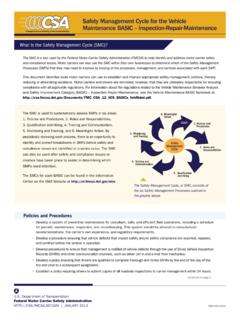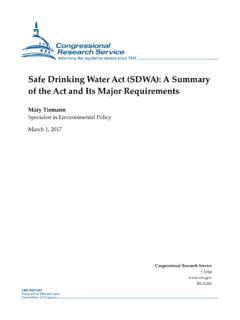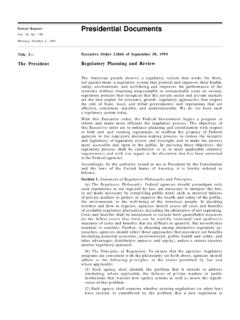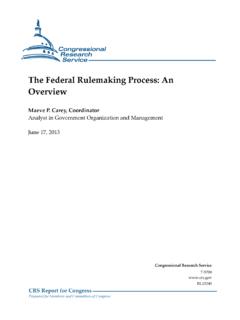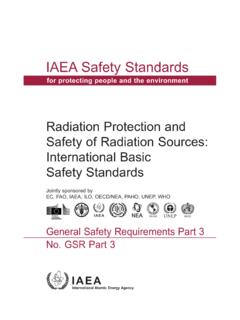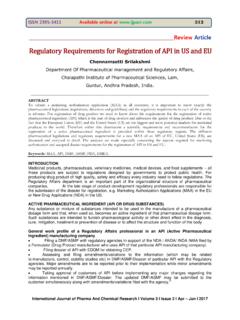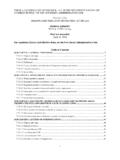Transcription of Resource for Development and Delivery of Training to …
1 Resource for Development and Delivery of Training to WorkersOSHA 3824-05R 2021 Occupational Safety and Health Act of 1970 To assure safe and healthful working conditions for working men and women; by authorizing enforcement of the standards developed under the Act; by assisting and encouraging the States in their efforts to assure safe and healthful working conditions; by providing for research, information, education, and Training in the field of occupational safety and Material contained in this publication is in the public domain and may be reproduced, fully or partially, without permission. Source credit is requested but not information will be made available to sensory-impaired individuals upon request. Voice phone: (202) 693-1999; teletypewriter (TTY) number: 1-877-889-5627. Cover photo courtesy of ACTA SafetyResource for Development and Delivery of Training to Department of LaborOccupational Safety and Health AdministrationOSHA 3824-05R 2021 DisclaimerThis guidance document is not a standard or regulation and it creates no new legal obligations.
2 The document is advisory in nature, informational in content, and is intended to assist employers in providing a safe and healthful workplace. The Occupational Safety and Health Act requires employers to comply with safety and health standards promulgated by OSHA or by a state with an OSHA-approved state plan. In addition, the Act s Section 5(a)(1), the General Duty Clause, requires employers to provide their workers with a workplace free from recognized hazards likely to cause death or serious physical harm. Employers can be cited for violating the General Duty Clause if there is a recognized hazard and they do not take reasonable steps to prevent or abate the hazard. However, failure to implement any specific recommendations contained within this document is not, in itself, a violation of the General Duty Clause. Citations can only be based on standards, regulations, and the General Duty of ContentsCharacteristics of Sound Training Programs.
3 2 Overview of Best Practices for Training Adults ..3 Principles of Adult Education ..5 The Principles of Adult Education: A Checklist ..7 Program Design, Delivery , and Evaluation Elements .. 12 Training Facilities and the Learning Environment ..12 Training Course Materials and Content ..14 Training and Overall Program Evaluation ..25 Specific Populations to Consider ..27 Appendix A ..29 Multilingual Resources ..29 Appendix B ..33 Program Evaluation and Quality Control Resources ..33 Evaluation Resources ..34 Appendix C ..35 References ..35 Appendix D ..38No Cost On-Site Safety and Health Consultation Services for Small Business ..38 OSHA Educational Materials ..39 Workers Rights ..39 OSHA Regional Offices ..40 How to Contact OSHA ..43 Resource FOR Development AND Delivery OF Training TO WORKERS1 More than 100 of OSHA s current standards contain requirements for Training .
4 Furthermore, a comprehensive workplace safety program needs to include Training . This OSHA guide outlines information on developing and delivering effective Training to workers. Quality safety and health Training helps prevent work-related injuries and illnesses. Effective Training also encourages workers by educating and empowering them to advocate for safer working factors contribute to successful Training . One of the most important is ensuring that the Training facilitator exhibits safety and health expertise, sound instructional skills and flexibility. This guide is a framework to ensure that quality Training is developed and delivered. In effective Training , participants should learn: How to identify the safety and health problems at their workplace; How to analyze the causes of these safety and health problems; How to bring about safer, healthier workplaces; and How to involve their co-workers in accomplishing all of the voluntary standards and minimum criteria guidance on developing and delivering safety and health Training exist and OSHA encourages you to review these documents as well: ANSI/ASSP Criteria for Accepted Practices in Safety, Health, and Environmental Training , ANSI/ASSP ANSI: American National Standards Institute ASSP: American Society of Safety Professionals NIEHS WETP Minimum Health and Safety Training Criteria Guidance for Hazardous OCCUPATIONAL SAFETY AND HEALTH ADMINISTRATION2 Waste Operations and Emergency Response (HAZWOPER).
5 HAZWOPER Supporting and All Hazards Prevention, Preparedness and Response. NIEHS: National Institute of Environmental Health Sciences WETP: Worker Education and Training ProgramCharacteristics of Sound Training ProgramsA general review of Training best practices reveals four characteristics that sound Training programs have in common. The best Training programs are accurate, credible, clear, and practical .Accurate . Training materials should be prepared by qualified individuals, updated as needed, and facilitated by appropriately qualified and experienced individuals employing appropriate Training techniques and . Training facilitators should have a general safety and health background or be a subject matter expert in a health or safety-related field. They should also have experience Training adults or experience working with the target population. Practical experience in the field of safety and health as well as experience in Training facilitation contribute to a higher degree of facilitator.
6 Training programs must not only be accurate and believable, but they must also be clear and understandable to the participant. If the material is only understandable to someone with a college education or someone who understands the jargon, then the program falls short of meeting workers FOR Development AND Delivery OF Training TO WORKERS3 Training materials should be written in the language and grammar of the everyday speech of the participants. Training developers should ensure that readability and language choices match the intended an employee does not speak or comprehend English, instruction must be provided in a language that the employee can understand. Similarly, if the employee s vocabulary is limited or there is evidence of low literacy among participants, the Training must account for this limitation. Remember that workers may be fluent in a language other than English, or they may have low literacy in both English and their primary language.
7 Training needs to be adjusted to accommodate all the factors that are . Training programs should present information, ideas, and skills that participants see as directly useful in their working lives. Successful transfer of learning occurs when the participant can see how information presented in a Training session can be applied in the of Best Practices for Training AdultsTraining providers and instructional facilitators who recognize and embrace characteristics of sound Training and principles of adult education will maximize the benefits of the Training for their participants. 1 . Intended audience . This guidance is intended for employers, safety officers, or any organization that provides occupational safety and health SAFETY AND HEALTH ADMINISTRATION42 . Training techniques, methods and modes . Proven adult learning techniques should be at the core of Training Development and Delivery .
8 Peer-to-peer Training with activity-based learning is one effective model for worker Training . Effective Development of peer trainers requires ongoing organizational support to the developing peer trainer. Activity-based learning should fill at least two-thirds of Training hours (no more than one-third is lecture). Training must be provided in a way that workers receiving it can understand. In practical terms, this means that the Training must be both in a language and vocabulary that the workers can understand. While computer-based Training (CBT) can augment the effectiveness of safety and health Training for workers, it should not be the sole form of Training that workers receive. 3 . Needs assessment . Safety and health Training should be preceded by a needs assessment to ensure the Training meets the needs of the participants. Needs assessments can also be used to learn more about your target population s knowledge, experience, learning styles, reading and writing skills, and interests.
9 4 . Evaluation of Training . Evaluating your Training allows you to assess whether the Training is having the desired results, and informs you as to whether you need to make changes to your Training FOR Development AND Delivery OF Training TO WORKERS5 Principles of Adult EducationThe following are the basic principles of how adults learn, which is directly applicable to safety and health Training programs: Adults are voluntary learners: Most adults learn because they want to. They learn best when they have decided they need to learn for a particular reason. Adults learn needed information quickly: Adults need to see that the subject matter and the methods are relevant to their lives and to what they want to learn. They have a right to know why the information is important to them. Adults come with a good deal of life experience that needs to be acknowledged: They should be encouraged to share their experiences and knowledge.
10 Adults need to be treated with respect: They resent an instructor who talks down to them or ignores their ideas and concerns. Adults learn more when they participate in the learning process: Adults need to be involved and actively participating in class. Adults learn best by doing: Adults need to try-on and practice what they are learning. They will retain more information when they use and practice their knowledge and skills in class. Adults need to know where they are heading: Learners need route maps with clear objectives. Each new piece of information needs to build logically on the last. Adults learn best when new information is reinforced and repeated: Adults need to hear things more than once. They need time to master new knowledge, skills, and attitudes. They need to have this mastery reinforced at every SAFETY AND HEALTH ADMINISTRATION6 Adults learn better when information is presented in different ways: They will learn better when an instructor uses a variety of teaching kinds of learning exchanges : Participant-to-Participant: Participant-to-participant learning exchange recognizes that participants can learn from one another s experiences.










